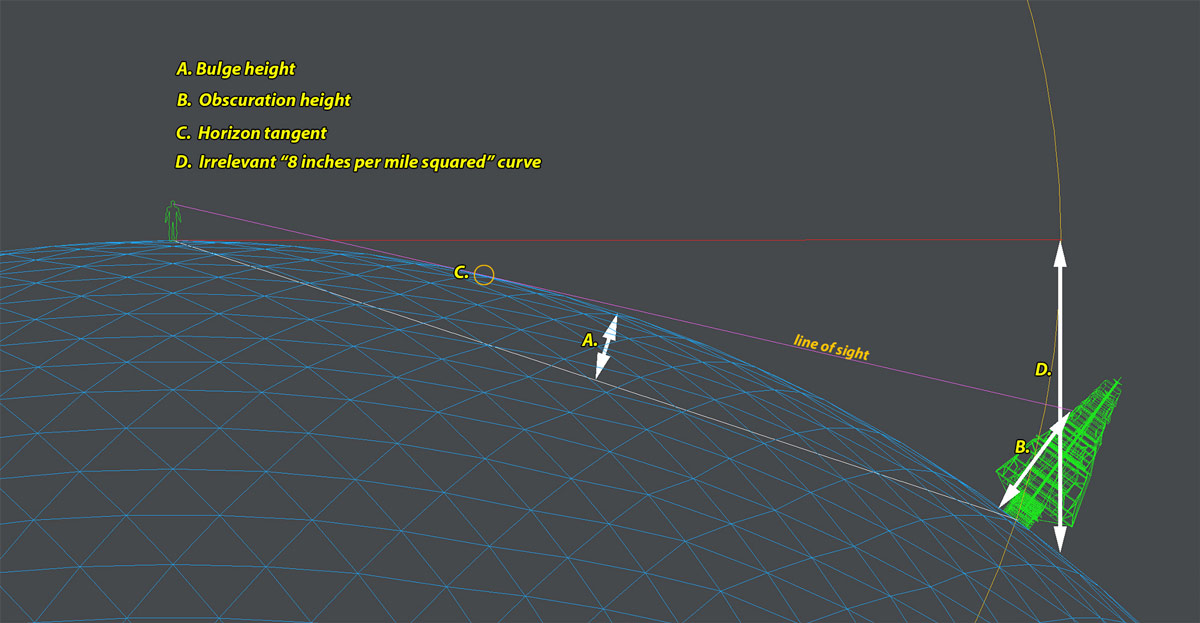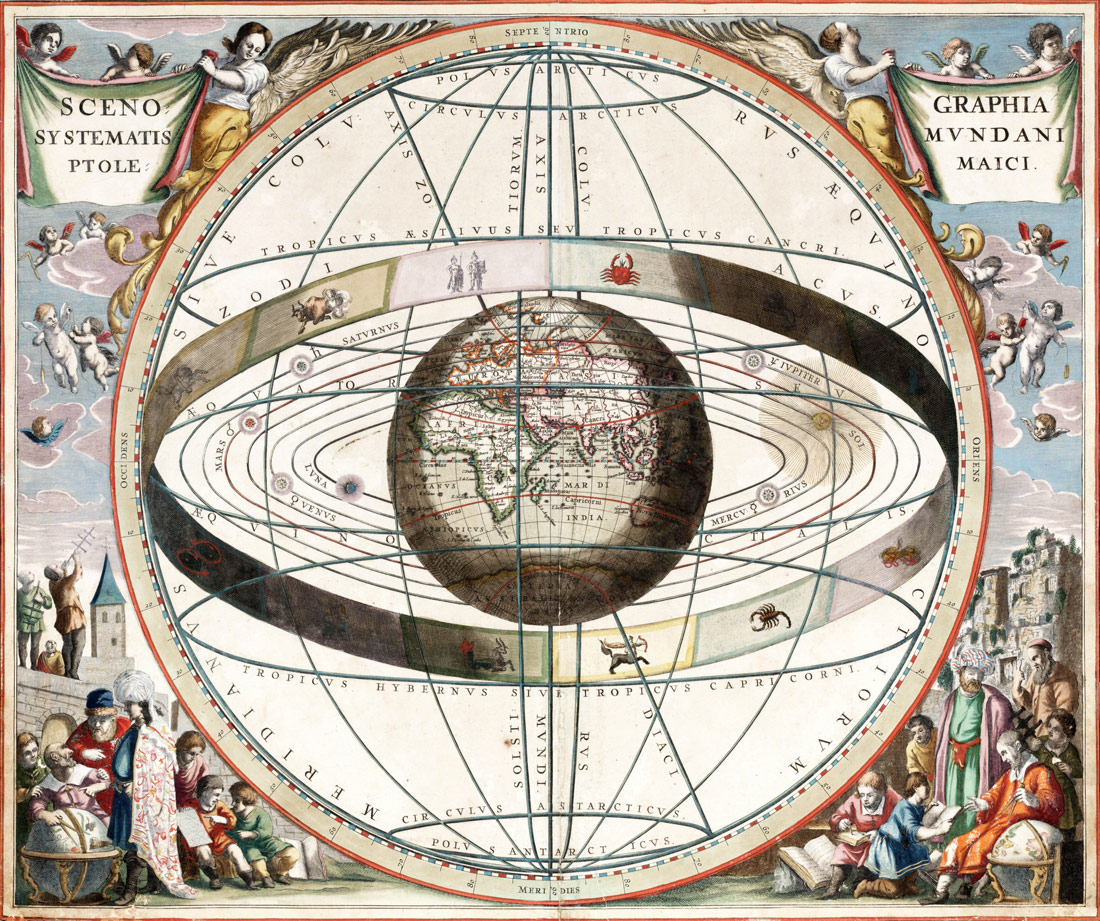Our evolving picture of the universe
Although as late as the time of Christopher Columbus it was common to find people who thought the earth was flat (and you can even find a few such people today), we can trace the roots of modern astronomy back to the ancient Greeks. Around 340 B. C., the Greek philosopher Aristotle wrote a book called On the Heavens. In that book, Aristotle made good arguments for believing that the earth was a sphere rather than flat like a plate.
One argument was based on eclipses of the moon. Aristotle realized that these eclipses were caused by the earth coming between the sun and the moon. When that happened, the earth would cast its shadow on the moon, causing the eclipse. Aristotle noticed that the earth’s shadow was always round. This is what you would expect if the earth was a sphere, but not if it was a flat disk. If the earth were a flat disk, its shadow would be round only if the eclipse happened at a time when the sun was directly under the centre of the disk. At other times the shadow would be elongated—in the shape of an ellipse (an ellipse is an elongated circle).
The Greeks had another argument for the earth being round. If the earth were flat, you would expect a ship approaching from the horizon to appear first as a tiny, featureless dot. Then, as it sailed closer,you would gradually be able to make out more detail, such as its sails and hull. But that is not what happens. When a ship appears on the horizon, the first things you see are the ship’s sails. Only later do you see its hull. The fact that a ship’s masts, rising high above the hull, are the first part of the ship to poke up over the horizon is evidence that the earth is a ball.
The Greeks also paid a lot of attention to the night sky. By Aristotle’s time, people had for centuries been recording how the lights in the night sky moved. They noticed that although almost all of the thousands of lights they saw seemed to move together across the sky, five of them (not counting the moon) did not. They would sometimes wander off from a regular east-west path and then double back. These lights were named planets—the Greek word for “wanderer.” The Greeks observed only five planets because five are all we can see with the naked eye: Mercury, Venus, Mars, Jupiter, andSaturn. Today we know why the planets take such unusual paths across the sky: though the stars hardly move at all in comparison to our solar system, the planets orbit the sun, so their motion in the night sky is much more complicated than the motion of the distant stars.

Aristotle thought that the earth was stationary and that the sun, the moon, the planets, and the stars moved in circular orbits about the earth. He believed this because he felt, for mystical reasons, that the earth was the centre of the universe and that circular motion was the most perfect. In the second century A.D. another Greek, Ptolemy, turned this idea into a complete model of the heavens. Ptolemy was passionate about his studies. “When I follow at my pleasure the serried multitude of the stars in their circular course,” he wrote, “my feet no longer touch the earth.”
In Ptolemy’s model, eight rotating spheres surrounded the earth. Each sphere was successively larger than the one before it, something like a Russian nesting doll. The earth was at the centre of the spheres. What lay beyond the last sphere was never made very clear, but it certainly was not part of mankind’s observable universe. Thus the outermost sphere was a kind of boundary, or container, for the universe. The stars occupied fixed positions on that sphere, so when it rotated, the stars stayed in the same positions relative to each other and rotated together, as a group, across the sky, just as we observe. The inner spheres carried the planets. These were not fixed to their respective spheres as the stars were, but moved upon their spheres in small circles called epicycles. As the planetary spheres rotated and the planets themselves moved upon their spheres, the paths they took relative to the earth were complex ones. In this way, Ptolemy was able to account for the fact that the observed paths of the planets were much more complicated than simple circles across the sky.
Ptolemy’s model provided a fairly accurate system for predicting the positions of heavenly bodies in the sky. But in order to predict these positions correctly, Ptolemy had to make an assumption that the moon followed a path that sometimes brought it twice as close to the earth as at other times. And that meant that the moon ought sometimes to appear twice as big as at other times! Ptolemy recognized this flaw, but nevertheless his model was generally, although not universally, accepted. It was adopted by the Christian church as the picture of the universe that was in accordance with scripture,for it had the great advantage that it left lots of room outside the sphere of fixed stars for heaven and hell.

Another model, however, was proposed in 1514 by a Polish priest, Nicolaus Copernicus. (At first,perhaps for fear of being branded a heretic by his church, Copernicus circulated his model anonymously.) Copernicus had the revolutionary idea that not all heavenly bodies must orbit the earth.In fact, his idea was that the sun was stationary at the centre of the solar system and that the earth and planets moved in circular orbits around the sun. Like Ptolemy’s model, Copernicus’s model worked well, but it did not perfectly match observation. Since it was much simpler than Ptolemy’s model,though, one might have expected people to embrace it. Yet nearly a century passed before this idea was taken seriously. Then two astronomers—the German Johannes Kepler and the Italian Galileo Galilei—started publicly to support the Copernican theory.
In 1609, Galileo started observing the night sky with a telescope, which had just been invented.When he looked at the planet Jupiter, Galileo found that it was accompanied by several small satellites or moons that orbited around it. This implied that everything did not have to orbit directly around the earth, as Aristotle and Ptolemy had thought. At the same time, Kepler improvedCopernicus’s theory, suggesting that the planets moved not in circles but in ellipses. With this change the predictions of the theory suddenly matched the observations. These events were the death blows to Ptolemy’s model.
Though elliptical orbits improved Copernicus’s model, as far as Kepler was concerned they were merely a makeshift hypothesis. That is because Kepler had preconceived ideas about nature that were not based on any observation: like Aristotle, he simply believed that ellipses were less perfect than circles. The idea that planets would move along such imperfect paths struck him as too ugly to be the final truth. Another thing that bothered Kepler was that he could not make elliptical orbits consistent with his idea that the planets were made to orbit the sun by magnetic forces. Although he was wrong about magnetic forces being the reason for the planets’ orbits, we have to give him credit for realizing that there must be a force responsible for the motion. The true explanation for why the planets orbit the sun was provided only much later, in 1687, when Sir Isaac Newton published his Philosophiae Naturalis Principia Mathematica, probably the most important single work ever published in the physical sciences.
In Principia, Newton presented a law stating that all objects at rest naturally stay at rest unless a force acts upon them, and described how the effects of force cause an object to move or change an object’s motion. So why do the planets move in ellipses around the sun? Newton said that a particular force was responsible, and claimed that it was the same force that made objects fall to the earth rather than remain at rest when you let go of them. He named that force gravity (before Newton the word gravity meant only either a serious mood or a quality of heaviness). He also invented the mathematics that showed numerically how objects react when a force such as gravity pulls on them, and he solved the resulting equations. In this way he was able to show that due to the gravity of the sun, the earth and other planets should move in an ellipse—just as Kepler had predicted! Newton claimed that his laws applied to everything in the universe, from a falling apple to the stars and planets. It was the first time in history anybody had explained the motion of the planets in terms of laws that also determine motion on earth, and it was the beginning of both modern physics and modern astronomy.
Without the concept of Ptolemy’s spheres, there was no longer any reason to assume the universe had a natural boundary, the outermost sphere. Moreover, since stars did not appear to change their positions apart from a rotation across the sky caused by the earth spinning on its axis, it became natural to suppose that the stars were objects like our sun but very much farther away. We had given up not only the idea that the earth is the centre of the universe but even the idea that our sun, and perhaps our solar system, were unique features of the cosmos. This change in worldview represented a profound transition in human thought: the beginning of our modern scientific understanding of the universe.
Contents
-
Chapter 1
Thinking about the universe
-
Chapter 2
Our evolving picture of the universe
-
Chapter 3
The nature of a scientific theory
-
Chapter 4
Newton's Universe
-
Chapter 5
Relativity
-
Chapter 6
Curved Space
-
Chapter 7
The expanding Universe
-
Chapter 8
The big bang, black holes, and the evolution of the universe
-
Chapter 9
Quantum Gravity
-
Chapter 10
Wormholes and time travel
-
Chapter 11
The forces of nature and the unification of physics
-
Chapter 12
Conclusion